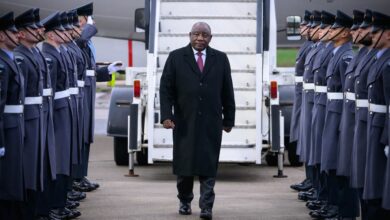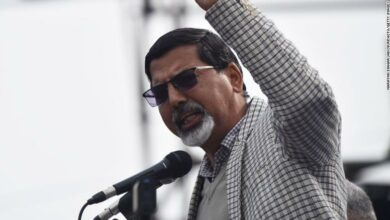Two weeks after being forcibly evicted from public housing, a group of families of the Duweiqa neighborhood are still homeless.
The families live in the Wahayed area of Duweiqa, an area perched on cliffs next to the Cairo Ring Road.
Duweiqa is reached by a road that winds steadily uphill. At its base is the burnt out shell of the Manshiyet Nasser district council office, opposite the still-operating Manshiyet Nasser police station.
The Suzanne Mubarak housing project in Wahayed is a collection of boxy but functional six-story white housing blocks with red shutters.
A group of people who lived in these apartments from January to July now live in shelters underneath their former homes.
Their shelters cling to the apartment blocks like rafts circling cruise liners, rickety homes constructed out of their owners' worldly belongings. One is made of a single bed turned on its side against a wall, with blankets forming a makeshift roof. A child sleeping on thin mattresses is visible through the “wall” of bed springs. Occupants have to crawl to get inside.
Manshiyet Nasser, of which Duweiqa is a part, is one of Cairo’s largest informal living areas. In 2006 the German NGO GTZ estimated that there are some 451,000 people living in the area, one of Cairo's earliest established informal settlements.
Duweiqa is famous because of the 2008 landslide that killed at least 120 people there, when huge boulders fell on the homes they had constructed beneath a cliff edge. The tragedy briefly pushed the issue of informal housing into the media spotlight and raised allegations of corruption in the allocation of housing.
Hind Sayed Abbas, a mother of three who appears to be the families' unofficial spokesperson, makes the same allegation.
Rather than being given to Duweiqa residents, Duweiqa public housing is routinely given to families from outside the area who can afford to bribe officials from the Manshiyat Nasser district council, Abbas alleges.
“Pay and you get an apartment, while we're left dumped from our rooms,” Abbas says.
Abbas explained how she and the others came to live in the apartments. She said that during the chaos of the 25 January revolution, thieves began stealing doors, blinds and anything else they could from the empty units.
Abbas says that the families moved into the flats to protect them, and that in any case, the housing was meant for them in the first place.
“A group of us, four families, were living in three-by-three meter rooms on the same street. We had been promised that the Suzanne Mubarak apartments were for us, for families from the Duweiqa slums. Everyone knows that this housing was made for us,” Abbas says.
“We thought that when a new government was formed after the revolution, officials would ask us where we were from and when they did, we would provide them with papers proving we're from Duweiqa and they'd give us tenancy," she continues.
Abbas and the other families went to the Heliopolis district council (the Manshiyet Nasser district council building was set on fire during the revolution) and were given case numbers. There also visited the Ministry of Defense, where they were instructed not to leave their apartments. They remained in them for five months.
Yassin Salah Eddin, head of the Manshiyet Nasser district council, told Al-Masry Al-Youm he had not slept for two days because he was resettling 145 families made homeless in Duweiqa.
The families were not protecting the apartments, Salah Eddin charges, but had actually acquired them illegally via middlemen.
“When these houses were completed and about to be handed to the governorate, the revolution happened and there was a lack of security. There were 510 flats and these were taken over by people who then sold them off to families in the area. They were seized in an illegal manner," he explains. "In June, police and army forces attempted to evict the buildings but they weren't enough and they couldn't manage to remove them, so they remained. The repercussion of this was that the state lost its authority in the area and many said that it was now possible to seize apartments."
He says the 3 July “campaign” to evict the families was aimed at providing accommodation for “tenants from the surrounding areas, especially for people who live in areas at risk on the mountain."
But Amnesty International researcher Mohammed Lotfy says that in September 2010, when the government announced that all 10,000 housing units of the Duweiqa project had been allocated, around 500 apartments remained empty.
“The 10,000 families or so living in 'unsafe areas' from rock falls in Manshiyet Nasser kept wondering why they were not given these empty flats. They don't understand why the Cairo Governorate has been relocating people into flats in Nahda City or 6 October City since March 2010, while those flats were still unoccupied. Then came the 2011 uprising and people broke into the flats, then the authorities forcibly evicted them to put in ‘right beneficiaries’ instead of them,” Lotfy says.
In one shelter, a man switches on an old computer monitor and showed Al-Masry Al-Youm what happened on 3 July.
Its yellow screen shows uniformed police officers and army soldiers firing guns seemingly at random, in an area filled with people, including children. One video shows a huge crowd of screaming people running from what looks like military police descending on them.
Abbas says the army and police arrived at 7 am. They went to a public housing block in a different part of Duweiqa, and Abbas and others went to see what they were doing.
Soldiers and policemen ignored people's pleas to look at papers proving they were residents of Duweiqa and therefore have a right to public housing in it, Abbas said. She said the police then attacked people, including women attempting to protect their children, in coordination with the army. Furniture was thrown off of balconies.
Abbas herself went to the Manshiyet Nasser police station. “Are you going to put me and my kids in the street?” she asked the head of the station. “He replied, 'You moved in peacefully didn't you? Well leave peacefully, so we don't have to force you out of there.'”
Salah Eddin justifies what he describes as a “show of strength."
“The squatters panicked but the army and police were merely firing in the air, not at them. And bear in mind this was the second attempt at evicting them and there had to be a show of strength, or we would have never been able to evict them and give the apartments to the people who need them,” Salah-Eddin says.
The families have been offered housing in the Masaken Othman district but, Abbas says, have refused, due to the complete absence of amenities there and the distance they would have to travel to their jobs and schools.
Salah Eddin acknowledges that the alternative housing offered by the state has problems. “It is true. There are problems here, a lack of amenities and long commutes being some of them, but what can we do? We are trying the best we can," he offers.
What the government should have done, Lotfy says, is allow the families to remain in the apartments until it found them suitable alternative accommodation – as Egypt is required to do under its international human rights law obligations.
The fact that the families were squatting does not affect the government’s duty towards them, Lotfy goes on, noting that “squatters of government housing have the same right not to be forcibly evicted as anyone else" and residents of Manshiyet Nasser are “effectively squatting state-owned desert land on which they built homes themselves.”
The absence of adequate and reasonable notice prior to eviction, genuine consultation with those affected, or legal remedies are some of the ways in which the authorities have failed the Duweiqa families, Lotfy says.
In the tents underneath the housing project, families deal pragmatically with the situation and borrow electricity from street lamps to fuel fans, computers and televisions.
One woman, Nada Mostafa, appears, carrying a tiny baby, Fahd, who, though being the size of an infant, is apparently almost six months old. He rests limply in her arms.
A volunteer pediatrician, Noha Nader, who has examined Fahd and other homeless children, says he weighs 2.5 kilograms and is severely undernourished. Poor diet has stunted the growth of most the infants Nader has examined; she says that almost all are shorter and lighter than they should be at their ages.
The children are otherwise resilient and in defiantly good spirits. This is in no small measure due to efforts from their mothers to keep them admirably clean and healthy, despite their chaotic surroundings. There are few men around; some work long hours, others have abandoned their families.
Another woman in her mid-20s, sluggish and sallow, tells Nader that it has been two weeks since her last dose of chemotherapy, inquiring how long she can wait until the next one. Nader tells her she must go as soon as possible.
“The problem is that the treatment completely knocks me out, I vomit and all I want to do is sleep for three or four days. I don't know how I will go through this here in a tent. I don't know who will take care of my kids,” she says.
Amal, a resolutely cheerful grandmother, cleans houses to support her family. She sold all her furniture so it wouldn't be stolen from her tent while she is at work. “All I want from the state is four walls, nothing else. I had that and they took it away," she says.
Additional reporting by Abdel-Rahman Hussein




